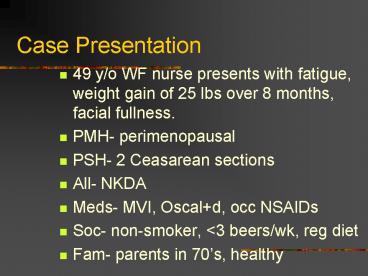Case Presentation - PowerPoint PPT Presentation
1 / 23
Title:
Case Presentation
Description:
... baasophilic tumor of the pituitary Evaluating Hypercortisolism All cases of endogenous Cushing s syndrome are due to increased production of cortisol by the ... – PowerPoint PPT presentation
Number of Views:76
Avg rating:3.0/5.0
Title: Case Presentation
1
Case Presentation
- 49 y/o WF nurse presents with fatigue, weight
gain of 25 lbs over 8 months, facial fullness. - PMH- perimenopausal
- PSH- 2 Ceasarean sections
- All- NKDA
- Meds- MVI, Oscald, occ NSAIDs
- Soc- non-smoker, lt3 beers/wk, reg diet
- Fam- parents in 70s, healthy
2
Case Presentation
- ROS-
- fatigue, wt gain, occ LE edema(mild),
irregular menses - - (denies) hair loss/thinning, dry skin,
polyuria, polydipsia, polyphasia, hot/cold
intolerance, indigestion, diarrhea, tremor, bone
pain.
3
(No Transcript)
4
(No Transcript)
5
Evaluating Hypercortisolism
- Douglas Stahura D.O.
- 3/6/2001
6
Evaluating Hypercortisolism
- Traditional definition of Cushings Disease is
ACTH-producing pituitary tumor, but may be any
hypersecretion of ACTH, regardless if tumor is
identified by radiography - Cushings syndrome characterized by
- Truncal obesity, hypertension, fatigability and
weakness, amenorrhea, hirsutism, abdominal
striae, edema, glucosuria, osteoporosis,
baasophilic tumor of the pituitary
7
Evaluating Hypercortisolism
- All cases of endogenous Cushings syndrome are
due to increased production of cortisol by the
adrenals - For pituitary-dependent adrenal hyperplasia
- Women 3Xgt men
- Age of onset 3rd or 4th decade
8
(No Transcript)
9
(No Transcript)
10
Evaluating Hypercortisolism
- Etiology most cases bilateral adrenal
hyperplasia is due to hypersecretion of pituitary
ACTH or production of ACTH by a nonendocrine
tumor - Small cell bronchogenic
- Thymus, pancreas, ovary
- Medullary carcinoma of thyroid
- Bronchial adenoma
11
(No Transcript)
12
(No Transcript)
13
Evaluating Hypercortisolism
- Screening Test
- Overnight Dexamethasone Suppression
- Dexamethasone 1mg PO _at_ 2400
- 0800 plasma cortisol level
- Normal less than 5 ug/dl
- A normal result implies that the ACTH control of
the adrenal glands is physiologically normal
14
(No Transcript)
15
Evaluating Hypercortisolism
- Low dose Suppression test
- Dexamethasone 0.5 mg PO q6h x48h
- Collect 24h urine for Cr/free cortisol levels on
2nd day - For normal pituitary-adrenal axis
- Urinary free cortisol lt 30 ug/dl
- Plasma cortisol lt5 ug/dl
- Test is directed at suppressing the PITUITARY
GLAND! (to show normal function)
16
(No Transcript)
17
(No Transcript)
18
Evaluating Hypercortisolism
- High Dose Suppression Test
- Dexamethasone 2 mg PO q6h x48 h
- Collect 24h urine for Cr/free cortisol levels on
2nd day - For normal pituitary-adrenal axis
- Urinary free cortisol lt 30 ug/dl
- Plasma cortisol lt5 ug/dl
- Test is directed at suppressing the Pituitary AND
Adrenals
19
(No Transcript)
20
Evaluating Hypercortisolism
- ACTH levels.
- Useful in diagnosing ACTH-independent etiologies.
Helpful if LOW.
21
Evaluating Hypercortisolism
- Dilemma
- Microadenoma of pituitary vs.
- Pituitary-hypothalamic dysfunction vs.
- Ectopic tumor production.
- MRI of pituitary gadolinium enhanced.
- Other imaging to rule out ectopic tumor
production of ACTH Lung, ovary, thymus. - .
22
Evaluating Hypercortisolism
- Petrosal sinus sampling
- Demonstrate an ACTH gradient between petrosal
sinus and peripheral blood.
23
(No Transcript)































